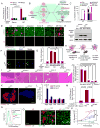Angiocrine factors deployed by tumor vascular niche induce B cell lymphoma invasiveness and chemoresistance
- PMID: 24651014
- PMCID: PMC4017921
- DOI: 10.1016/j.ccr.2014.02.005
Angiocrine factors deployed by tumor vascular niche induce B cell lymphoma invasiveness and chemoresistance
Abstract
Tumor endothelial cells (ECs) promote cancer progression in ways beyond their role as conduits supporting metabolism. However, it is unknown how vascular niche-derived paracrine factors, defined as angiocrine factors, provoke tumor aggressiveness. Here, we show that FGF4 produced by B cell lymphoma cells (LCs) through activating FGFR1 upregulates the Notch ligand Jagged1 (Jag1) on neighboring ECs. In turn, upregulation of Jag1 on ECs reciprocally induces Notch2-Hey1 in LCs. This crosstalk enforces aggressive CD44(+)IGF1R(+)CSF1R(+) LC phenotypes, including extranodal invasion and chemoresistance. Inducible EC-selective deletion of Fgfr1 or Jag1 in the Eμ-Myc lymphoma model or impairing Notch2 signaling in mouse and human LCs diminished lymphoma aggressiveness and prolonged mouse survival. Thus, targeting the angiocrine FGF4-FGFR1/Jag1-Notch2 loop inhibits LC aggressiveness and enhances chemosensitivity.
Copyright © 2014 Elsevier Inc. All rights reserved.
Figures








Comment in
-
A jagged road to lymphoma aggressiveness.Cancer Cell. 2014 Mar 17;25(3):261-3. doi: 10.1016/j.ccr.2014.03.001. Cancer Cell. 2014. PMID: 24651005 Free PMC article.
-
Microenvironment: Endothelial cells create a niche.Nat Rev Cancer. 2014 May;14(5):298. doi: 10.1038/nrc3730. Epub 2014 Apr 10. Nat Rev Cancer. 2014. PMID: 24722428 No abstract available.
Similar articles
-
A jagged road to lymphoma aggressiveness.Cancer Cell. 2014 Mar 17;25(3):261-3. doi: 10.1016/j.ccr.2014.03.001. Cancer Cell. 2014. PMID: 24651005 Free PMC article.
-
Microenvironment: Endothelial cells create a niche.Nat Rev Cancer. 2014 May;14(5):298. doi: 10.1038/nrc3730. Epub 2014 Apr 10. Nat Rev Cancer. 2014. PMID: 24722428 No abstract available.
-
Notch signaling drives multiple myeloma induced osteoclastogenesis.Oncotarget. 2014 Nov 15;5(21):10393-406. doi: 10.18632/oncotarget.2084. Oncotarget. 2014. PMID: 25257302 Free PMC article.
-
Renal involvement and the role of Notch signalling in Alagille syndrome.Nat Rev Nephrol. 2013 Jul;9(7):409-18. doi: 10.1038/nrneph.2013.102. Epub 2013 Jun 11. Nat Rev Nephrol. 2013. PMID: 23752887 Review.
-
Blockade of Jagged/Notch pathway abrogates transforming growth factor β2-induced epithelial-mesenchymal transition in human retinal pigment epithelium cells.Curr Mol Med. 2014 May;14(4):523-34. doi: 10.2174/1566524014666140331230411. Curr Mol Med. 2014. PMID: 24694299 Review.
Cited by
-
The Therapeutic Potential of a Strategy to Prevent Acute Myeloid Leukemia Stem Cell Reprogramming in Older Patients.Int J Mol Sci. 2023 Jul 27;24(15):12037. doi: 10.3390/ijms241512037. Int J Mol Sci. 2023. PMID: 37569414 Free PMC article. Review.
-
Wnt-mediated endothelial transformation into mesenchymal stem cell-like cells induces chemoresistance in glioblastoma.Sci Transl Med. 2020 Feb 26;12(532):eaay7522. doi: 10.1126/scitranslmed.aay7522. Sci Transl Med. 2020. PMID: 32102932 Free PMC article.
-
Vascular niche IL-6 induces alternative macrophage activation in glioblastoma through HIF-2α.Nat Commun. 2018 Feb 8;9(1):559. doi: 10.1038/s41467-018-03050-0. Nat Commun. 2018. PMID: 29422647 Free PMC article.
-
Circulating and disseminated tumor cells: harbingers or initiators of metastasis?Mol Oncol. 2017 Jan;11(1):40-61. doi: 10.1002/1878-0261.12022. Mol Oncol. 2017. PMID: 28085223 Free PMC article. Review.
-
Molecular Checkpoint Decisions Made by Subverted Vascular Niche Transform Indolent Tumor Cells into Chemoresistant Cancer Stem Cells.Cancer Cell. 2017 Jan 9;31(1):110-126. doi: 10.1016/j.ccell.2016.11.010. Epub 2016 Dec 15. Cancer Cell. 2017. PMID: 27989801 Free PMC article.
References
-
- Beck B, Driessens G, Goossens S, Youssef KK, Kuchnio A, Caauwe A, Sotiropoulou PA, Loges S, Lapouge G, Candi A, et al. A vascular niche and a VEGF-Nrp1 loop regulate the initiation and stemness of skin tumours. Nature. 2011;478:399–403. - PubMed
-
- Benedito R, Roca C, Sorensen I, Adams S, Gossler A, Fruttiger M, Adams RH. The notch ligands Dll4 and Jagged1 have opposing effects on angiogenesis. Cell. 2009;137:1124–1135. - PubMed
Publication types
MeSH terms
Substances
Associated data
- Actions
Grants and funding
- CA163167/CA/NCI NIH HHS/United States
- R21 CA159175/CA/NCI NIH HHS/United States
- R01 HL084619/HL/NHLBI NIH HHS/United States
- R01HL097797/HL/NHLBI NIH HHS/United States
- HL055748/HL/NHLBI NIH HHS/United States
- HL119872/HL/NHLBI NIH HHS/United States
- R01 HL055748/HL/NHLBI NIH HHS/United States
- U54CA163167/CA/NCI NIH HHS/United States
- R01HL119872/HL/NHLBI NIH HHS/United States
- R01 HL119872/HL/NHLBI NIH HHS/United States
- CA159175/CA/NCI NIH HHS/United States
- RC2 HL101846/HL/NHLBI NIH HHS/United States
- RC2HL101846/HL/NHLBI NIH HHS/United States
- U54 CA163167/CA/NCI NIH HHS/United States
- R01 DK095039/DK/NIDDK NIH HHS/United States
- F32 CA177139/CA/NCI NIH HHS/United States
- R01 HL097797/HL/NHLBI NIH HHS/United States
LinkOut - more resources
Full Text Sources
Other Literature Sources
Molecular Biology Databases
Miscellaneous

